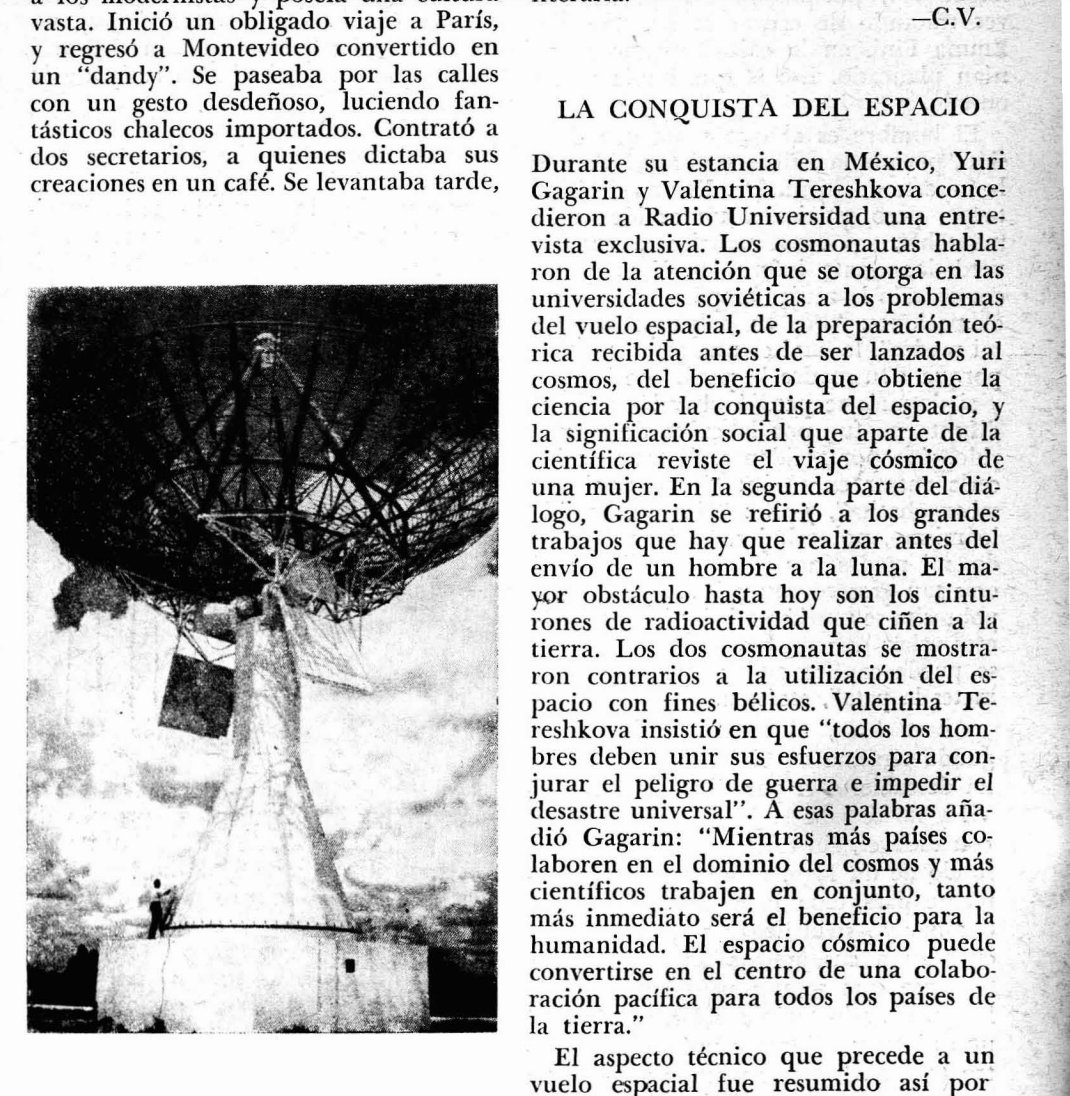Cosmonautics day | Valentina Tereshkova and Yuri Gagarin in Mexico [English version]
Cosmonautics day | Valentina Tereshkova and Yuri Gagarin in Mexico (English version)
 |
| (Ledesma, 2022) |
Today, April 12th, we commemorate Cosmonautics Day because of the first space voyage by cosmonaut Yuri Gagarin. That is why today we will remember the interview that the cosmonauts, Valentina Tereshkova and Yuri Gagarin, gave to Radio UNAM during their visit to Mexico, my home country (Archivo Sonoro, 2018).
It is important to point out that during the famous space race, on April 12th, 1961, the USSR managed to send the first man into space, Yuri Gagarin, who would become the first cosmonaut (United Press International, 1961). While on June 16th, 1963, Valentina Tereshkova became the first woman to travel into space, that is, the first female cosmonaut (The New York Times, 2022).
In October 1963, Valentina and Yuri visited Mexico City for the international aeronautical congress, where they were received by President Adolfo López Mateos. It should be noted that this was the only interview that they offered to Mexican broadcasters during their visit (Ledesma, 2022).
 |
| (Archivo Sonoro, 2018) |
Another question that Gagarin is asked is about the scientific studies that cosmonauts must carry out. In the first place, the cosmonaut points out that he must know the rocket’s mechanism, its components, know its entire constriction and its handling. In the same way, they should have knowledge in physics, mathematics, geophysics, astronomy, and the exploration of the cosmos. Something that is expected of a cosmonaut is that he not only be a pilot on the flight, but also a researcher during the journey.
The interview continues by discussing how spaceflight contributes to promoting scientific progress. Gagarin answers that science disciplines in cosmic flight are always interrelated; that is, the development of one helps the development of another. Likewise, he points out how cosmonautics not only helps scientific development but also the inner development of oneself.
 |
| (Archivo Sonoro, 2018). |
On the other hand, cosmonaut Tereshkova is asked about the social significance of the woman's journey to outer space. She points out that this trip has great social importance, although since 1917 the women in the USSR had broken the chains of slavery. Meaning, they worked equally in factories, participated in public administration, and managed positions in companies. She points out that it would be wrong to say that before her flight the women of the USSR were far from cosmic problems, since many of them participated in the construction of rockets. Vostok 6 illustrates that women can not only lead the flight of rockets but also in their construction, since they have the same abilities as men. Tereshkova expressed her pride in contributing to eradicating the chains of slavery for women.
 |
| (Archivo Sonoro, 2018). |
Gagarin is asked to what extent does the conquest of space can contribute to the conservation of peace on Earth. He talks about how when he made his cosmic journey, he thought ” do not let the black ashes of war cover the beauty of Earth”. He points out that our generation knows the errors of war through the books and stories of our mothers and grandparents, that is why the men of the Earth must join forces to avoid universal disaster. Yuri adds that the cosmic space is endless, the more countries that collaborate in the domain of the cosmos, the faster it will be achieved for the benefit of humanity. He added that the cosmic space can become a peaceful arena for the collaboration of all men on earth. Tereshkova intervenes by pointing out that we cannot allow the use of external space for war purposes.
 |
| (Archivo Sonoro, 2018). |
Finally, the cosmonauts add that when they visited CU they had a meeting with a group of university students to whom they pointed out the crucial path that opens before them and the tasks that they must solve. Gagarin talks about the importance of knowledge networks at the university but also knowing how to take advantage of them in practical life. The value of specialists is measured by what they contribute to the daily life of society, says the cosmonaut. Likewise, Tereshkova adds that she wants these young people to acquire knowledge and apply it for peaceful purposes so that they are creating and never destroying (Archivo Sonoro, 2018).
References
Archivo Sonoro. (2018). Radio UNAM entrevista a Yuri Gagarin y Valentina Tereschkova. Archivosonoro.org. https://www.archivosonoro.org/archivos/radio-unam-entrevista-a-yuri-gagarin-y-valentina-tereschkova/
Ledesma, R. (2022). La conquista del espacio | Revista de la Universidad de México. Revista de La Universidad de México. https://www.revistadelauniversidad.mx/articles/4a5c4667-9c78-410a-b7f2-90eb780123fb/la-conquista-del-espacio
Sputnik Mundo. (2021, April 12). ¿Cómo fue la visita de Yuri Gagarin a México en 1963? Sputnik Mundo. https://mundo.sputniknews.com/20210412/como-fue-la-visita-de-yuri-gagarin-a-mexico-en-1963-1111083598.html
The New York Times. (2022). How the Soviets Won the Space Race for Equality (Published 2019). The New York Times. https://www.nytimes.com/2019/07/16/us/how-the-soviets-won-the-space-race-for-equality.html
United Press International. (1961). 187-MILE HEIGH; Yuri Gagarin, a Major Makes the Flight in 5-Ton Vehicle Russians Succeed in Orbiting an Astronaut and Returning Him Safely to Earth SOVIET IN TOUCH WITH SPACE MAN Successful Launching of Yuri Gagarin in “East” Sputnik Is Announced in Moscow (Published 1961). The New York Times. https://www.nytimes.com/1961/04/12/archives/187mile-heigh-yuri-gagarin-a-major-makes-the-flight-in-5ton-vehicle.html



Comments
Post a Comment